What is a Ling Pai 令牌?

Tokens, also known as 五雷号令 “Five Thunder Orders” or 天皇号令 “Heaven Emperor’s Orders”, are instruments used by priests to summon and dispatch generals. “Summoning generals” means summoning heavenly generals. 雷法 Leifa (a Taoist spell of summoning wind, summoning rain, and subduing demons) theory holds that the priest holds a token and hits the side of the token with the calligraphy in the air to summon the heavenly generals and make them appear.It is said the token sees the true form. To “Summoning generals”, also known as “dispatching generals”,the Master conveys the purpose of this ritual by reciting sacred incantations, such as praying for rain, opening sunshine, expelling evil, etc., and then using the order will issue specific instructions to display all kinds of mighty spirits.
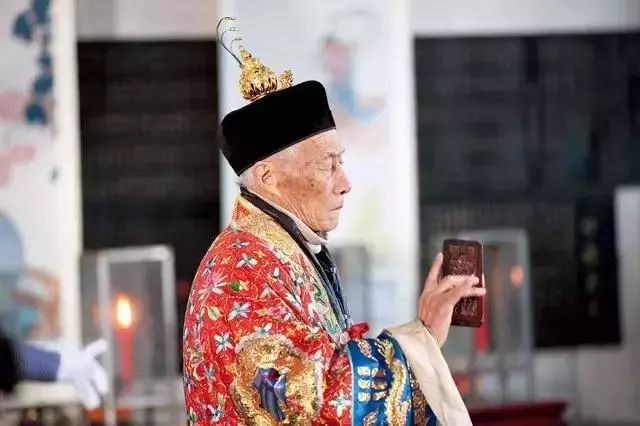
(Master Xue Honghao send generals with tokens)
Usually, the order needs to be coordinated with the priests intention (referring to the impression formed in the mind), internal energy and ancestral Qi 炁 (similar to sound: Qi气, Taoism refers to the energy in the human body). When a Master calls a general, he needs to “mix” the external Qi with the internal Qi in the “Thunder City” (which can be understood as “Aura”) in the body.
Next, dip the upper left corner of the token with holy water and draw a 乾卦”Qian Gua” representing Quanyang on the southeast 巽 Xùn position of the table, then guide the Qi inside body to go out , make three strikes. “One strike to open the gate of heaven, two strikes to split the earth, and three strikes to bring down all gods.” The purpose of this is to break the “Qian Gua” into the “Kun Gua” of all yin or the “Xun Gua” representing wind and thunder. ” During the “Three Strikes and Ten Thousand Gods Come Down”, the Master also cooperated with intention, “a golden light flew from the corner of the table”, and rushed to the “Heaven Gate” on the northwest corner, so that the Heavenly Sovereign Officer would fly to the altar with fire and gold to hear the decree.
Different types of Taoist tokens and their use?
The tokens of the Qin’an Hall of the Forbidden City mainly belong to Qingwei, Shenxiao, Lingbao and Fengdu Pai. Below we display tokens also used in Zheng Yi and Quan Zhen Pai.
清微派 “Qingwei Pai” system token

Qingwei Jade System Token 清微令
This kind of token is extremely rare in the market, and it can be seen that the physical significance of the preservation of Qin’an Hall is of great significance. Most of the remaining tokens can be found in the Qingwei Taoist collection with similar runes, but it is difficult to determine their origins.

The Heavenly Order Token 天一令
Qingwei Pai, according to the 《清微仙谱》 “Qingwei Xian Pu”, this method originated from Zu Shu, a native of Lingling, Guangxi in the late Tang Dynasty, and was awarded the Lei Fa to Huang Shunshen by the ninth generation of Nanbi Dao. Huang Sui was famous for his skill in Lei Fa. Lizong of the Southern Song Dynasty summoned him. In the 23rd year (1286) of Yuan Shizu, he was summoned and conferred the title of “Lei Yuanguang Fu Pu Hua Zhenren”.
According to 《清微应运》”Qing Wei Shi Yun”, its method was passed down from the Yuanshi Tianwang (Yuanshi Tianzun), which brought together the essence of the four schools of 上清、灵宝、道德、正一 “Shangqing, Lingbao, Dao De, and Zhengyi”, emphasizing people’s internal training and external use. The root of Taoism’s effectiveness is that external use is the embodiment of internal training, so it is called “quietness will mate with dragons and tigers, and movement will cause thunderstorms”.
神霄法 “Shenxiao Pai” system token
Shenxiao method, which appeared in the late Northern Song Dynasty, was represented by Lin Lingsu and Wang Wenqing during the Huizong period. Judging from the documents and existing ceremonies, the method inherits the content of the early “Lingbao Jing”, and adds the “Three Thunder Commanders” (Deng, Xin and Zhang Tianjun) as its characteristics, focusing on external the “Yaosha Deduction” and the internal “Refining of True Qi” emphasize the theory that “internal cultivation is elixir, external application is thunder”.

The wodden Heavenly Emperor’s Order of “Shenxiaofa” System Token 天皇号令
It is now displayed in a brocade box on a small red lacquer and gold scroll case in Qin’an Hall. The front side is embossed with the human head and snake body figure of 勾陈天皇大帝 “Gouchen Emperor”, engraved are names of deities and thundergods. The reverse side has the words of Emperor’s Order sacred names of gods and the names of the 28 stars.
The emperor holds the sun in his left hand and the sword in his right hand. His unkempt head and fangs are angry, his eyes and tongue can move, and he is surrounded by 讳字 Hui Zi. “Hong”, “Teng” and “Ming” at the top represent the “three clearities Hui Zi” of the Sanqing, and the Hui Zi characters below it are Yuanyang God (middle), Tieshi God (right), Xuanyuan God (left), and then go down it is the Jade Emperor (middle), the Heavenly Emperor (right), and Ziwei (left).
The emperor is surrounded by thirty-six thunder characters, representing the thirty-six generals of the Thunder Department. In the middle of the back is the inscription “The Emperor’s Order”, with the Hui Zi of Dou Mu in the middle. Then down are Xingzhu Hui Zi (middle), Dou Mu Yang Hui Zi (right), Dou Mu Yin Hui Zi (left), and at the bottom of the “Emperor’s Order” symbol are Jade Emperor, Lei Zun, and Heavenly Father Hui Zi. There are twenty-character secret spells on both sides of the “Emperor’s Order”, which are arranged in pairs and surrounded by twenty-eight constellations. On the top of the token, there is a “inner Hui Zi” – “唵吽吒唎”, and the base is engraved with the five emperors.
The token of 五雷号令 “Five Thunders Order” published in 《大成金书》”Dacheng Golden Book”
Later generations have left a large number of works of Shenxiao Fa of different periods and masters, such as the earlier book 《高上神霄紫书大法》, which roughly follows the content and logic of 《灵宝度人经》”Lingbao Du Renjing”, and does not explicitly propose a token use. 《高上神霄玉枢斩勘五雷大法》 focuses on the summoning of 欻火律令邓天君 and the 五方蛮雷.
However, tokens based on the spells in 邓天君 “Deng Tianjun” and 斩勘法 “Zhan kanfa” appeared in later generations. 《先天雷晶隐书》 “Xiantian Leijing Hidden Book” emphasizes 天母 and 天皇. Among the generals of 雷部 Thunder Department , 张天君 Zhang Tianjun and 天皇号令 “Heaven Emperor’s Order” is more commonly used together. Tokens of Heavenly Soldiers, Heavenly Generals, and Leibu Immortals).

The ancestral decree of “Shenxiaofa” system token 祖讳令
The token is an ancestral decree, with a red sticker on the upper right side of the front, with the inscription “北方敕镇法坛用”. The engraved talisman on the top is basically consistent with the order of 祖讳 “Ancestor Sacred Name” or 使者号 “Messenger Number” in 神霄法 “Shenxiao Fa”, and it is surrounded by 后天八卦 “Hou Tian Bagua”. Its shape is different from ordinary tokens. It is inferred from the content on the red sticker that it was used when the 斋醮仪式 Zhaijiao ceremony was used to decree the altar of the north.

The Fire Order of “Shenxiaofa” System Token 欻火令
The front of this talisman is engraved with words such as “天敕天摄天灭地敕地摄地灭令”, and the back has the words “雷霆都司欻火律令”.
Token of 酆都法 “Fengdu Order”

In 《 高上神霄玉枢斩勘五雷大法》published 辛天君信符 Faith Talisman of Xin Tianjun.

The “Faith Talisman” published in《高上神霄玉枢斩勘五雷大法》used with 九泉号令 “Jiuquan Decree” in 酆都法 “Fengdu Order”.
There are six types of tokens in this order, collectively referred to as 酆都法 “Fengdu Order”, mainly including 酆都号令 “Fengdu Order” and 酆都正令 “Fengdu Zheng Order”. The former is made of jujube wood, five 寸 “Cun” long, two 寸 “Cun” and four 分 “fen” wide, and eight 分 “fen” thick. It is carved according to the 六丁日 “Six Ding Days”. Officials and soldiers are fierce, and they dare to stop when they have orders. If they refuse and disobey orders, it brings constant punishment.

九泉号令 “Jiuquan Decree” of 酆都法 “Fengdu Order”
The order of Jiuquan and the token used in “Fengdu Fa” are displayed in the Palace Museum, and are displayed on a small red lacquer and gold scroll case in Qin’an Hall
The front of the token is engraved with the words “Jiuquan Command Talisman” and a secret spell arranged in the shape of “P”, and the back is engraved with astrological symbols and 敕 “chì”.
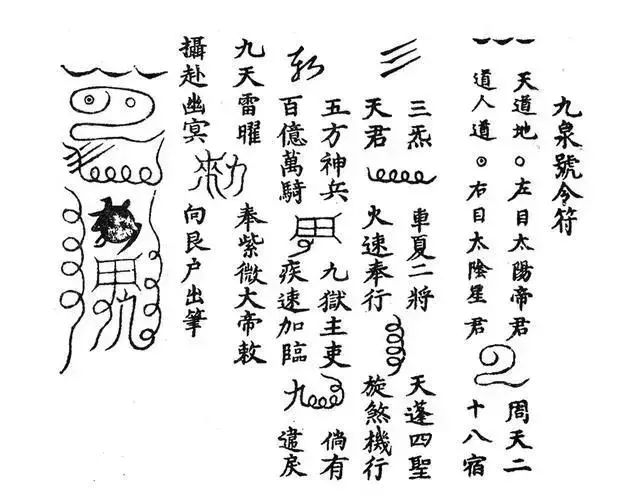
九泉号令符 “Jiuquan Command Symbol” published in 《酆都车夏二秘法》
According to records, the latter was used by Zheng Zhiwei (a Taoist priest in the Song Dynasty), and it needs to cooperate with the 黑律 “Black Law” and 北帝派道书 (Northern Emperor’s Taoist script in order to function according to the method. The order has a chilling atmosphere, so it is necessary to choose 癸亥日Guihai Day and 亥日 Hai Days (the last of the Heavenly Stems and Earthly Branches), the Ten Evil Defeated Days (甲辰 Jiachen, 乙巳 Yisi, 丙申 Bingshen,丁亥 Dinghai, 戊戌 Wuxu, 己丑 Jichu, 庚辰 Gengchen, 辛巳 Xinsi, 壬申 Renshen, 癸亥 Guihai). During these ten days business affairs and festive events are forbidden, also death day (unlucky day) and other days with a strong meaning of “death”.
Jujube wood, cypress wood, maple wood, peach wood and catalpa wood are the most important in the choice of wood, other woods should not be used. There is also a clear taboo in the order, that is, the order cannot be passed on to those who have broken the body and shattered the body (referring to those who have been punished, imprisoned or exiled).

The inside of the Jiuquan Order Token used in the “Fengdu Order”
Tokens used in 灵宝法 “Ling Bao Fa” with 玉清总召万灵符命 “Yuqing Summons All Souls Talisman”
The 灵宝斋法 “Lingbao Zhai method” focuses on making a furnace and being released from official positions. There is no token mentioned in the ancient book. The 《灵宝领教济度金书》 of the late Song and early Yuan Dynasty began to display the token, and was teaching the 东华教法 “Donghua Teaching Method”. The master should hold the token and recite the incantations.
Later, the master can grant the token to the disciple, and the disciple receives it after three rites. The disciples of the order must be equipped with the command post and the seal of governance, in order to be able to serve the three world spirit officials.

Left: “Yuqing General Summons All Souls Talisman” published in 《灵宝领教济度金书》
Middle & Right: The token used in “Lingbao Order”
Commandment Ruler 净尺

召陶元帅 秘号 “Calling Marshal (secret number/name)” published in 《雷霆欻火张使者秘法》

Clear wooden ruler in the collection of the Palace Museum. It is now displayed in the brocade box on the red lacquer and gold small volume bookcase in Qin’an Hall
There is also a wooden token which is a 净尺 “ruler”. The five-sided talisman is different from ordinary tokens, and it is a Taoist magic weapon or tool with a function similar to “gavel”. During the fasting ceremony, the priest will instruct the generals on behalf of the Tianzun. This token is engraved with talismans on all sides, comparing the literature and tracing its origin, it should be closely related to the 天医陶元帅 “Heavenly Doctor Marshal Tao “.
Laojun Token
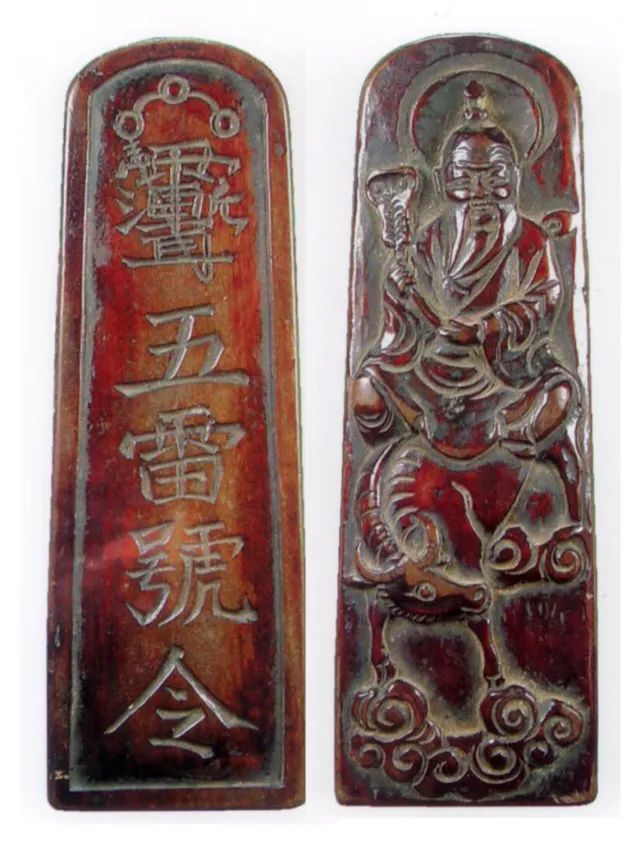
老君令
On the front is the embossed Taishang Laojun. He is holding a banana fan, wearing a purple-gold crown, three long beards, smiling kindly, sitting on a green ox, and the ox treads on the clouds. Means to travel around the world. The top of the back is engraved with three star maps, below which are the 讳字 secrets name of Emperor Ziwei. It is composed of the three characters “rain, gradual and ear”, and the pronunciation is “灵”, with a total of twenty-eight strokes, symbolizing the twenty-eight constellations. At the bottom is the four characters 五雷号令 “Five Thunder Command”. On both sides are engraved with the inscription “敢有不服,寸斩分形” , the top of the token is engraved with the word “天”, and the bottom of the token is engraved with the secret “炓” of Tiangang.
Celestial Master Token
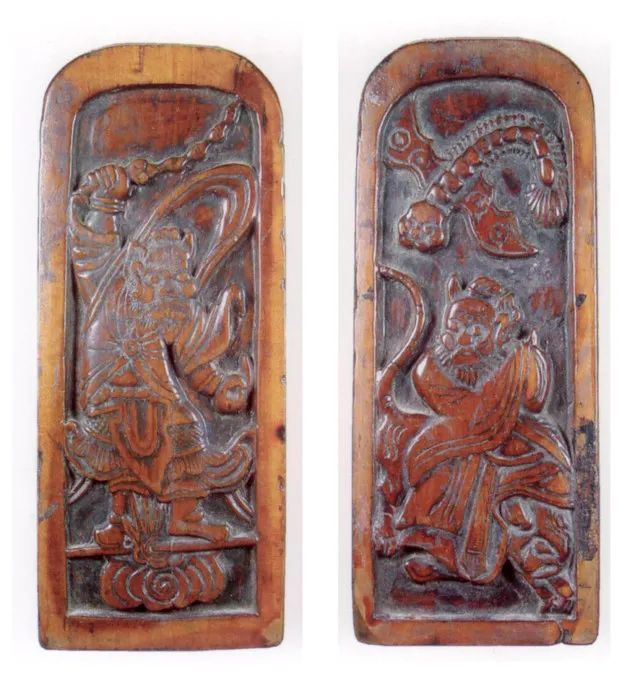
天师令
The front is embossed with the ancestral celestial master Zhang Daoling, the celestial master with dragon eyebrows and leopard eyes, with a celestial eye on his forehead, a beard with horns and a beard, wearing a purple-gold crown on his head, his hands arched, and sitting on the back of a fierce tiger. There are centipedes, scorpions, poisonous snakes, toads and geckos on the head, which means to exorcise evil spirits. The back is embossed Wang Lingguan, wearing a purple-gold crown, staring angrily, with an eye on the forehead, red hair and red beard, holding a golden whip in the left hand, pinching the Lingguan handseal with the right hand, wearing a golden armor, a coat of war robes, and stepping on a fire wheel, majestic and fierce.
Five Thunder Command
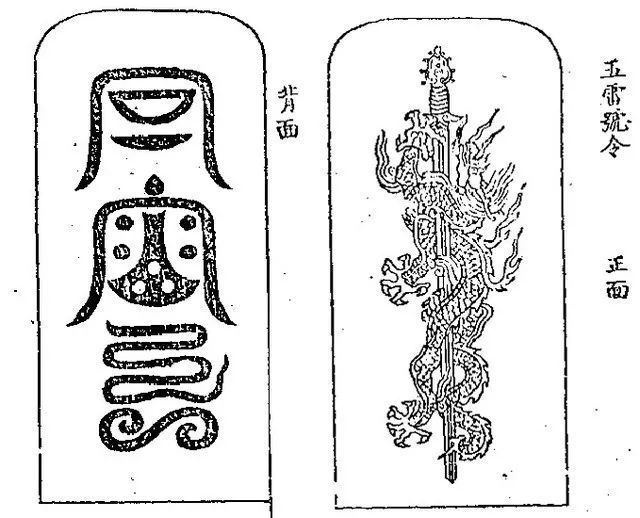
The 五雷号令 “Order of the Five Thunders” is taken from 《大成金书》 of the Qing Dynasty
The Order of the Five Thunders was passed down by the Shenxiao School of the Song Dynasty. 《大成金书》 volume 25 says: “The right token is made of jujube wood struck by lightning, five cun long, two cun wide and five fen thick. Choose auspicious days, according to it is built in a style, and the names of the twenty-eight places are published around the four sides, and the treasures are contained.” The front is embossed with a sword, the hilt is on the top, the blade is on the bottom, the sword body is surrounded by a golden dragon, and the golden dragon’s claws are five claws. Around to the hilt, the dragon head is on the top, the dragon tail is on the bottom, and the dragon’s body has obvious flame patterns. The text on the back is simple, only the words “Five Thunder Command” are in cloud seal.
Ling Guan Token
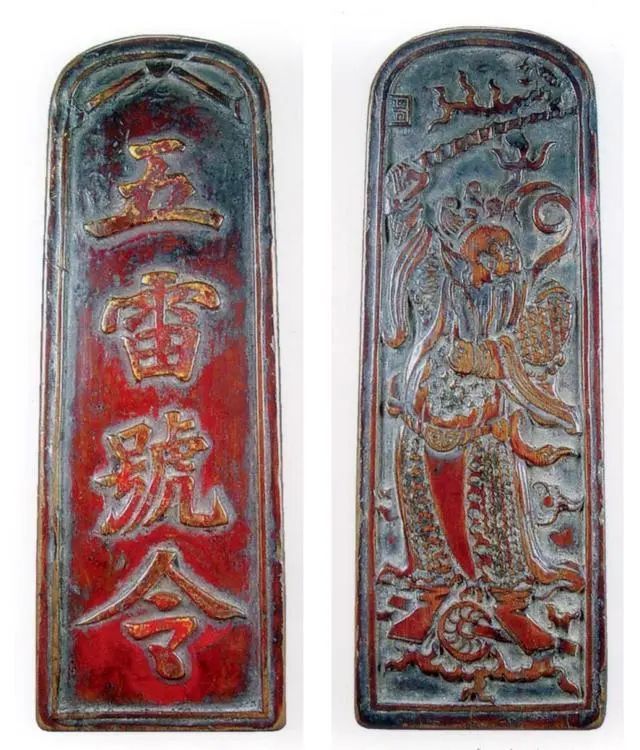
灵官令
The front is embossed with the Taoist Protector Wang Lingguan, wearing a purple-gold crown, staring angrily, with eyes on the forehead, red hair and red beard, holding a golden whip in the left, pinching the Lingguan handseal on the right, wearing a golden armor, a coat of war robe, stepping on a fire wheel, majestic and fierce . The text on the back is simple, with three star maps engraved on the top, and the words “Five Thunder Command” below it.
Marshal Yin Token
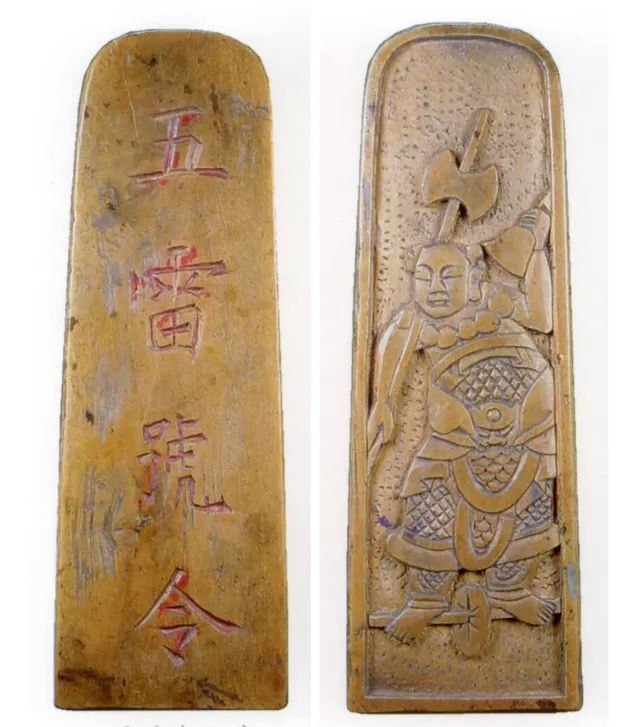
殷帅令
The front is embossed with the Taoist guardian Marshal Yin Jiao, and the back is only engraved with the words “Five Thunder Command”. According to the 《三教搜神大全》, Yin Shuai was the eldest son of King Zhou of Shang. He holds a golden bell in his right hand, wears a golden armor, and steps on a fire wheel, majestic and fierce.
Marshal Ma Token
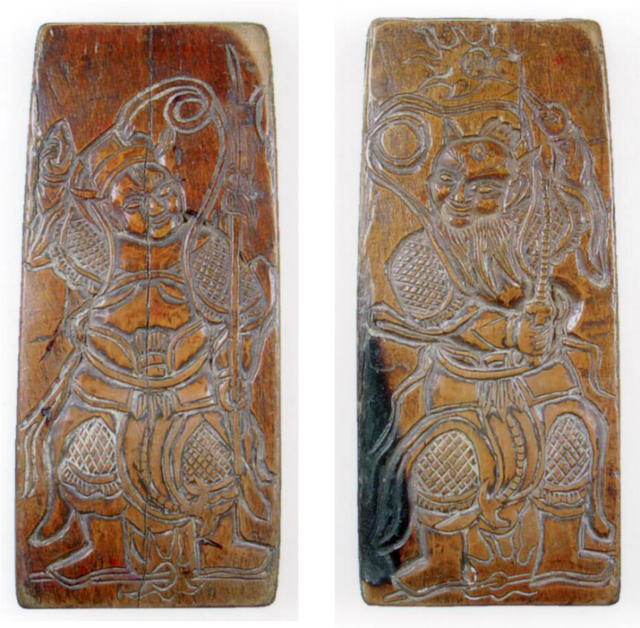
马帅令
Ma Shuai is embossed on the front, and Wang Lingguan is embossed on the back. Ma Shuai has a celestial eye on his forehead, wears three mountain crowns on his head, and is dressed in chain mail. He holds a golden brick in his left hand with an eye on the brick. He holds a Fangtianhua halberd in his right, with a white snake wrapped around the halberd, and he steps on a fire wheel. The Taoist Protector Wang Lingguan is embossed on the back, wearing a purple-gold crown, staring with anger, with eyes on the forehead, red hair and red beard, holding a golden whip in the left, pinching the Lingguan handseal in the right, wearing a golden armor, a coat of war robe, stepping on a fire wheel, majestic and fierce .
Written and Translated by Daoist Liu Cheng Yong, German Daoist Association.

